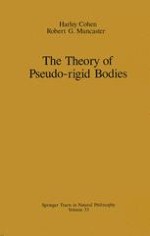1988 | OriginalPaper | Chapter
Foundations of the Theory of Pseudo-rigid Bodies
Authors : Harley Cohen, Robert G. Muncaster
Published in: The Theory of Pseudo-rigid Bodies
Publisher: Springer New York
Included in: Professional Book Archive
Activate our intelligent search to find suitable subject content or patents.
Select sections of text to find matching patents with Artificial Intelligence. powered by
Select sections of text to find additional relevant content using AI-assisted search. powered by
A pseudo-rigid body, seen from one perspective, is a generalization of a rigid body that accounts for the effects of deformation. In order to lay the foundations for a theory of such bodies, it is useful to begin by revising our view of rigid bodies. While physically we perceive a rigid body to be an object of finite size, analytically we characterize it only through the position of its center of mass and the orientation of its remaining points relative to a set of axes fixed in space. More concisely, a rigid body may be viewed as a moving point to which is attached a time-varying measure of orientation. In this way, we may view the mechanics of rigid bodies as a theory of a special directed continuum. As an immediate generalization, we define a pseudo-rigid body here to be a moving point to which is attached a measure of both orientation and deformation, and we base our formulation of a theory for it on the general principles that have been developed in recent years for the study of directed continua.
